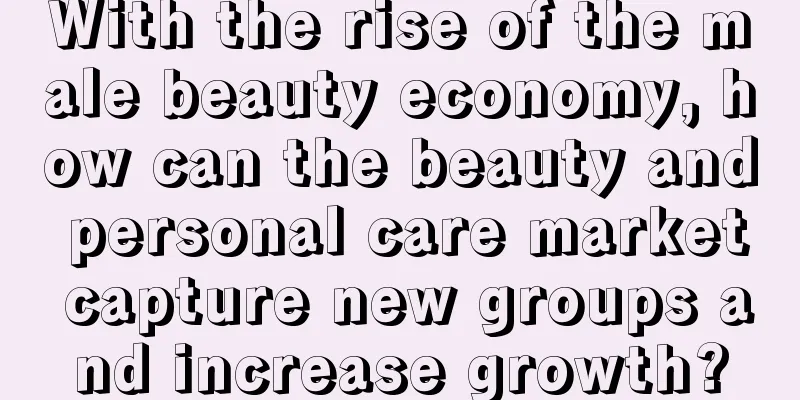With the rise of the male beauty economy, how can the beauty and personal care market capture new groups and increase growth?

Men are becoming an important force in the beauty and personal care market. According to Nint Rentuo data, among the high-growth categories of beauty and personal care in the first quarter of 2022, sales of men's personal care categories reached 18.27 million yuan, ranking first with a year-on-year growth rate of 804.66%, far exceeding the year-on-year growth of the overall market. Hot-selling men's personal care products include hair wax, hairspray, shampoo, etc. According to Nint Rentuo data, since November 2021, the men's personal care market has maintained its heat for several quarters, with monthly sales reaching more than 5 million yuan. Men, who were once at the end of the consumption contempt chain, are now taking up the banner of self-pleasing consumption and appearance consumption. They are paying more and more attention to the all-round care and management of their bodies. According to the data from Aowei Cloud Network in the first quarter of last year, in terms of personal care small appliances, the growth rate of male consumption far exceeded that of female consumption, and they paid more attention to their appearance. For example, the two portable shavers "Little Flying Saucer" and "Little Planet" sold well by Feike in the past two years have hit the target of many male consumption scenarios such as emergency and remedial travel. Razors, as a necessity for men's personal care, are just the tip of the iceberg of the male beauty economy. Skin care, hair care, and beauty products mainly consisting of foundation and perfume have opened up a broader blue ocean market. As we all know, the growth of the personal care market since the outbreak has been mainly driven by new concepts in sub-categories, such as body lotion and sunscreen. This reflects that consumers are taking better care of themselves, not just their faces, but also every inch of exquisite details from hair to feet. Men are no exception. So, why is the male beauty economy on the rise? What do different consumer profiles expect from appearance? What is the potential for the male beauty economy? The Community Marketing Institute will answer the above questions based on the "White Paper on Chinese Men's Grooming" . 1. What is the potential for development in the male beauty economy consisting of beauty and personal care products?The puppy style, the wolf style, the cross-dressing show, the street look, the atmosphere...Since when, social media has become more and more demanding in terms of men's looks. On social media platforms, more and more boys are beginning to share their tips on skin care, makeup, hair care, shoes and clothing. In 2022, the male beauty economy, mainly beauty and personal care, will reach more than 30 billion yuan, including shaving, skin care, beauty, washing and other market segments. So, which market segments have larger capacity or more growth potential? 1. Skin care accounts for a high proportion and has a high growth rate. There are also many sub-sectors with huge potential, including sprays, toners, sunscreens, etc. When boys want to be handsome, skin care is essential. According to TMIC data, more than 60% of men will buy skin care products for themselves, and this track is expected to have an average annual compound growth rate of more than 15% from 2021 to 2026. The reason for the high proportion of skin care is simple: young people generally take anti-aging measures in advance, which is no longer a gender-related issue. Skin care is the most basic face-saving project. In addition, there are many sub-sectors in the skin care market, and consumers have a lot of room for advancement. The skin from head to toe can be cared for: some parts need acid scrubbing, some parts need anti-allergic or moisturizing... Different skin areas, different skin types, different weather, and different scenes are suitable for different product ingredients. 2. Hair determines a boy’s first impression. Cleaning + styling + maintenance constitute the basics of hair care. Social opinion generally believes that hairstyle largely determines the first impression a boy gives: keeping hair from being greasy and getting a haircut in time are the basics, but being able to style your own hair at home will give you even more points. Therefore, in daily hair care consumption, the main products are hair cleaning (basic functions include cleaning, dandruff removal, oil control, etc.) + hair styling (mainly through hair mud, hair wax, styling spray, to meet the needs of soft/hard hair to achieve a layered hairstyle) products; In addition, with the increasing competition in education and the workplace, hair loss is becoming younger. Among the consumption of preventive and targeted hair care products, scalp care products and products with hair strengthening and hair volume effects are the main ones. 3. Low penetration and high growth of beauty products. “Pseudo-bare-face” promotion and blogger recommendations are the key to customer acquisition Among all the categories of the male beauty economy, beauty products have the lowest share, but at the same time the growth rate is also very fast. This is mainly driven by young men buying foundation and items to enhance their atmosphere. Data shows that more than 10% of post-95s will buy cosmetics for themselves. In addition, women can wear heavy makeup, but it is also a trend for boys to pretend to be bare-faced, so it is difficult to tell whether the base makeup products such as eyebrow pencils, foundation, concealer, contour powder, etc., and trendy items that focus on creating a sense of temperament and atmosphere, such as frames, beauty contact lenses, perfumes, etc. are more popular with men. As men pay more and more attention to the details of their appearance, bloggers' opinions such as "Boys should also be fresh", "Boys should also be able to put on makeup without makeup", and "Boys will have a market as long as they learn fitness and skin care" have become very useful. Men's anxiety about appearance has begun to emerge. The "average level of Douyin" and "average level of Xiaohongshu" have raised the aesthetic threshold of most people, but data shows that more than half of male users are from third-tier cities and below. Of course, those beauty bloggers who have tens of thousands to millions of fans on the entire network are a rare 1%. The premise for them to capture fans is not only their appearance, but also their good aesthetics. At the same time, they must be able to cater to public sentiment and social hot spots, maintain a high frequency of updates, establish a differentiated personality, and share real, interesting and useful appearance-enhancing tips with every exquisite pig boy. Because men's aesthetic awareness of appearance management has just emerged and they lack experience, they will be more influenced by bloggers/peers/girlfriends, especially when it comes to more emotional items such as beauty products. They will listen more to bloggers' opinions and further purchase items based on their own height/appearance/budget/purchase season/high-frequency wearing scenarios/ideal personality and other conditions. 2. Every exquisite pig boy has a different ideal personalityBased on age, city level, life stage, purchasing power level, and purchases of beauty and personal care products in the past year, the male beauty economy will form five core groups: grooming novices, trendy men, quality upstarts, pragmatic dads, and sophisticated uncles. The first category, 35% are novices in grooming. They are aged 18-25. The former live in third-tier and lower cities, have slightly lower purchasing power, and pay more attention to basic cleaning products such as hair washing, styling, and shaving. Since they are still in the ignorant stage of appearance management, their aesthetic taste tends to be refreshing and clean, avoiding slovenliness. Their purchasing power further determines that they prefer affordable brands or men's brands. The second category, 20%, is trendy men. They are aged 18-25, live in first- and second-tier cities, have medium purchasing power, and their beauty and personal care products include skin care + hair + basic makeup (such as men's BB), which is also the core male audience for makeup. Since they are highly receptive to new things in life and have decent purchasing power, but are still in the exploration stage of appearance management, they hope to form an all-round trendy male image through the replacement and combination of different trendy things: cleaning, fitness, dressing, accessories and other trendy items will not be left out. Therefore, advanced skin care products such as facial masks, nose patches, cosmetics such as BB cream, perfume, and hair styling products are all powerful tools for them to improve their appearance. Emerging domestic brands with high cost performance, trendy brands with a sense of design, and brands with gender-neutral designs will all be given special consideration. The third category, 23%, is the new elites of quality. Most of them are between 25 and 35 years old, live in high-tier cities, have medium to high purchasing power, have a deep understanding of beauty and personal care products, and especially prefer eye creams, essences and other powerful skin care products. They regard the style and goals of appearance management as one of the symbols of their lifestyle and taste in life. Moreover, they are in the fastest career growth period of their lives and are willing to exchange consumption for a sense of accomplishment. Therefore, categories that can better reflect their precise control over life, and their aesthetics and insights that are different from others, often have a larger market: emerging niche categories with high appearance and black technology, such as beauty devices and water flossers, are one of them; skin whitening, hair care, hairstyle styling and other products with high customer orders and that enhance appearance details are also one of them; mid-to-high-end skin care brands are their favorite. The fourth category, 15%, is pragmatic dads. They are aged 30-40, live in third-tier cities and below, have medium purchasing power, but have basic consumption needs for beauty and personal care products, have low budgets, and prefer cost-effective brands of moisturizing, skin care, and anti-hair loss products; This group of people have been family-aged for many years and, influenced by family values, prefer a masculine aesthetic that is spiritual, clean, and natural. So even if their income is not low, their budget is limited. They pay more attention to basic items such as moisturizing and cleansing, and value the product's cost-effectiveness. The fifth category, only 7% are sophisticated uncles. They are 35-40 years old, live in 1-3 tier cities, have the highest purchasing power, know how to take care of the face and body in all directions, not only like to use body lotion to take care of the skin, but also pay attention to the management of hair all over the body, and prefer high-end brands. This group of people is the rarest. They are willing to pay for a high-quality life, love sports, love skin care, have taste in consumption, and appearance management is also one of the manifestations of their high-quality life. Their age stage determines that they pay more attention to skin anti-aging such as eye cream, face cream and other categories, hair loss prevention such as hair essence and hair care and other categories, body care such as body lotion and other categories, and high-end line products of high-end brands are more likely to be favored. ConclusionIt is a thing of the past that men have less spending power than dogs. This is an era of appearance economy. Every product, every information stream, and every living person is wrapped, modified, and collaged through filters before being pushed to consumers. Men's appearance is magnified by social media, scrutinized by the public, and inspires more self-management, which is also a trivial trend in this wave. In the above classification of the male beauty economy, we can clearly see that it is age and income, rather than other personal factors such as the city of residence and education level, that influence their consumption of beauty and personal care products. An extreme example is that the majority of men who are willing to consume foundation products are those born after 1995. As the age range increases, although the spending power and average customer spending have increased, their aesthetics are also becoming more conservative - excluding the only 7% of sophisticated uncles who have achieved a high degree of economic freedom. Gain insight into the penetration level of different categories among different generations, and carry out market education at the corresponding stages. For example, the post-00s focus on beauty and cosmetics needs, the post-90s focus on anti-aging and anti-aging needs, and the post-70s and post-80s focus on hair management needs. This is the key strategy for beauty and personal care brands to capture new male growth. |
<<: Private domain traffic solutions for different enterprises
>>: A guide to practicing your brand voice
Recommend
Young people who are so sophisticated and stingy are turning supermarkets into outlet malls
With the development of the new economy, consumers...
Do 3C products on Shopee need to be certified? How to upload products on Shopee?
We know that some e-commerce platforms require cer...
How to build a private domain operation system?
For enterprises, the question of whether to operat...
One article to quickly unlock: the entire process of the label system
When should the labeling system be built in the an...
Revelation from the Spring Festival period of short short dramas: Can the two promote each other?
This article deeply analyzes the development trend...
Can I return items purchased from eBay without any conditions?
eBay online shopping inevitably involves the issue...
How long does it take to register VAT on Amazon Europe? How to apply for VAT on Amazon Europe?
When we open a store on the Amazon platform, merch...
eBay announced its withdrawal from the French Black Friday event in 2022
In order to comply with the trend of sustainable d...
Programmatic SEO
In the wave of digital marketing, obtaining free t...
The next step for "new wine drinks" - rebuilding value and breaking through barriers with 5 new perspectives
What new developments will new alcoholic beverages...
Data people, how do you judge whether the company is "reusing" you or "exploiting" you?
In the data-driven era, data talents are highly so...
Tik Tok launches gift-giving red envelopes. Will big companies stage another red envelope war?
Since WeChat Store updated the gift-giving functio...
Can I cancel Amazon Prime after 30 days of trial? How to activate Amazon Prime?
Amazon's trial membership program has attracte...
Community Operations | What is the #topic# in the content community?
In this article, the author will share with you so...
2 yuan tea hits the "crispy" young people, selling 1.15 million cups in one day
This summer, Chinese herbal tea substitutes have u...









